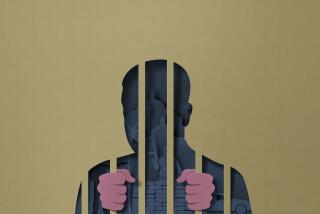Gangster Angst : LITTLE MAN: Meyer Lansky and the Gangster Life, <i> By Robert Lacey (Little, Brown: $24.95; 547 pp.)</i>
- Share via
Meyer Lansky. When you heard the name, you shivered. He was the cold-eyed financial genius behind the omnipresent, omniscient Mob. God help America. For decades, the mention of Lansky inspired visions of thick stacks of cancerous cash eating away at the ethics of judges, cops, politicians, businessmen and union leaders. In an era when gangsters were both glorified and feared, Lansky was the most sinister and elusive of that generally flamboyant crowd. He was the shadowy mastermind of countless illicit enterprises, the Svengali who really pulled the strings while his col leagues were busy defining the gangster life style, getting gunned down in barbershops or buying diamond stickpins big as the Ritz.
Pretty soon, these goodfellas, who for a time rivaled the Communist threat to the American Way, were going to control just about everything, the press and ambitious reform politicians warned. In the late 1960s, an enterprising Miami reporter tagged Lansky’s personal worth at $300 million, indirect proof of this looming outlaw’s putsch. It was a fortune bigger than the economies of some nations, and the number stuck to Lansky like a wad of chewed gum. This vast amount, worth billions in today’s dollars, seemed to epitomize his most famous quote: “We’re bigger than General Motors.”
Clearly, honesty was for chumps.
The gangster mystique probably peaked in the early 1970s with the first two of “The Godfather” movies. Robert Lacey describes this apogee in his entertaining and fascinating portrait of Lansky and his world: “The gangster definitively replaced the cowboy as the necessary myth for a neurotic society--the man who raised his arm when it all got too much of him, and, BOOM, just blew everything away. What was intimidating in real life became the dream of escape when experienced in the weightless universe of fantasy.”
Fans of dark conspiracies will be disappointed, then, to also learn in “Little Man: Meyer Lansky and the Gangster Life” that hardly any of this glittering, ominous hype is true, especially about Meyer Lansky. Sure, Lansky made a few bundles, primarily from gambling and taking a fee for computing complicated shareouts on gangland deals. True to legend, he was a wizard with numbers, so good that he could recalculate baseball players’ batting averages in his head while watching a game. He was also, by the standards of his peers, an intellectual. Bugsy Siegel got a charge out of the fact that Lansky was a member of the Book-of-the-Month Club.
But actually Lansky was a mediocre businessman, Lacey reports. He failed twice in ventures to set up legitimate businesses. One of them, a scheme to build and sell TV sets to bars, went belly-up because the sets often failed to work. A Lansky investment in oil wells did pay off for a while, but after his death in 1983, the value of the investment went south, wiping out the rather paltry estate he had left behind. The $300 million? No way, asserts Lacey.
What Meyer Lansky really knew was how to run a casino or gaming house. After breaking into full-time gangsterism as a Manhattan bootlegger during Prohibition, Lansky established himself with enterprises in Saratoga, Miami, Las Vegas and Havana. Mostly, he ran a smooth operation; the gambling was clean, the entertainment excellent, the food good. Most of all, it was peaceful and hassle-free. Nobody got perforated in front of the blackjack table and bled all over the cards, cash and chips. When Cuba got a deserved reputation for running sucker games, dictator Fulgencio Batista called in Lansky and friends to clean up the action. As Lacey notes, the only way to run an honest casino in the Western Hemisphere was to call in the hoods.
Lansky’s professional life topped out with the construction and opening of the Riviera Hotel and Casino in Havana just before Fidel Castro came to power. While it lasted, Lansky had a world-class establishment. He took his duties as kitchen manager very seriously indeed. But for politics, Lansky would have been set for life. More important, he finally would have made the transition to legitimate businessman, a goal that was forever beyond his lengthy grasp.
Following Castro’s rise, Lansky’s fortunes went into decline. He spent the rest of his life fighting the Feds in a series of court battles. He won all of them, enhancing his already inflated reputation for invulnerability. What prosecutors failed to grasp, as Lacey persuasively argues, is that there never has been anything as coherent as a centrally controlled Mob or Mafia in American life. Rather, organized crime is hydra-headed: a lot of big ego, quick-buck artists linked only by the deals they make with each other. Organized crime is fluid, a series of deals between an ever-shifting number of partners. It is not a corporation with clear lines of authority and responsibility--as the crusading U.S. Estes Kefauver and a host of district attorneys have believed. Thus, Lansky controlled almost nothing, Lacey argues with the support of impressive research. Yes, he says, there are and were gangsters and they were a rough bunch of dudes. But they never could get it together enough to really threaten the nation.
As for Lansky, his happiest period probably was a brief stay in Israel, where he sought citizenship but was rejected for his past. Lansky’s journey to the Middle East was a return to his Jewish roots. Until about age 10 he had lived in the town of Grodno, then part of Czarist Russia. After coming to America, Lansky drifted away from those beginnings. The birth of Israel began to draw him back, at least in a cultural and nationalistic sense. He helped the new state obtain weapons and was generous with his donations. Yet Israel’s supreme court rejected his plea for permanent residency, proving to Lansky that some things are beyond price.
Lansky’s origins were a vital part of his legend, Lacey writes: “Often hinted at, if seldom explicitly stated, Meyer Lansky’s Jewishness was an important part of his mystique,” he writes. “ . . . The myth of his omnipotence provided people with a satisfyingly clear and simple explanation of evil--and since he was omnipotent, it was only natural that no one could come up with chapter and verse to sustain the case against him. He knew how to hide the evidence.”
Over his life, Lansky also learned the bitterness behind the cliche that money cannot buy love. A distant, undemonstrative man, Lansky had a rocky home life with his first wife, who in her later years declined into extreme eccentricity, keeping cockroaches for pets in her cluttered New York apartment. Lansky’s three children fared little better. His daughter and two sons all were emotionally scarred. Buddy Lansky, born with cerebral palsy, had the worst deal. Although his father sought the best in medical care, Buddy’s condition never improved more than marginally, and the evaporation of his father’s estate forced him into a welfare home. Lacey uses the story of Buddy Lansky as a counterpoint to Meyer Lansky’s own story. Buddy’s fate provides a heartbreaking ending to this superb work of revisionism.
More to Read
The biggest entertainment stories
Get our big stories about Hollywood, film, television, music, arts, culture and more right in your inbox as soon as they publish.
You may occasionally receive promotional content from the Los Angeles Times.










